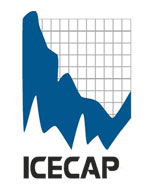Don J. Easterbrook, Dept. of Geology, Western Washington University, Bellingham, WA
The recent Portland State University study of glaciers on Mt. Adams by is a good example of bad science, i.e., how a dogmatic bias and selectively leaving out contrary factual data can lead to bad conclusions. As an exercise in critical thinking, I used to have my graduate students take a paper like this apart, piece by piece, to show any scientific errors. Here is an analysis of bad assumptions and errors in the Mt. Adams study.
First, what are the basic contentions in this study?
1. Washington’s gradually warming temperatures have caused Mount Adams to shrink by nearly half since 1904.
2. The Mt. Adams glaciers are receding faster than those of nearby sister volcanoes.
3. The glacier recession is another sign of gradually warming temperatures.
4. The study lends urgency to an earlier federal report that shows the water content of Cascade Mountain snowpacks could dwindle by as much as 50 percent by the 2070s.
Let’s take a careful look at each of these. Have the Mt. Adams glaciers indeed shrunk by nearly half since 1904? How do we prove such a statement? The best way is to have photographic evidence of where the glacier termini were in 1904 and where they are now. For the moment, let’s assume they have shrunk significantly since 1904. But the rest of the conclusion (gradually warming temperatures have caused them to shrink) isn’t a logical consequence of smaller glaciers. Two important aspects of this question are (1) has the climate gradually warmed over the past 100 years and (2) what were the glaciers doing before 1904?
The answer to the question, has the climate gradually warmed over the past 100 years, is no, the climate has not gradually warmed - it has oscillated back and forth between warm and cool periods four times during the past century (Figure 1), and the glaciers have fluctuated back and forth with the climate changes. The inference that the Mt. Adams glaciers began to retreat near the turn of the past century and have gradually shrunk because of gradual warming due to increased CO2 is false.
>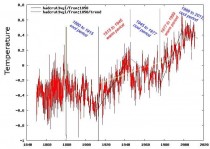
Figure 1. The climate during the past century has fluctuated through two periods of global warming and two periods of global cooling. Each time the climate cooled, the glaciers advanced; each time the climate warmed, they retreated.
The answer to the question, what were the glaciers doing immediately prior to 1904 is that they were strongly advancing during the 1880 to 1915 cool period, and many reached terminal positions close to their maximum extent during the Little Ice Age (1300 AD to this century) (Figure 2). Most of the subsequent retreat of the glaciers occurred during the following warm period from 1915 to 1945, well before CO2 began to rise sharply after 1945.
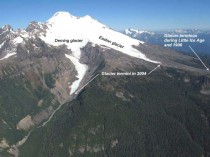
Figure 2. Position of glacier termini of the Easton and Deming glaciers on Mt. Baker (another Cascade volcano similar to Mt. Adams). The glacier termini in 1906 were close to their maximum Little Ice Age extent because of 30 years of strong climatic cooling from 1880 to about 1915. The recent glacier termini are at their minimum extent because of the preceding 20 years (1978 to 1998) of climatic warming.
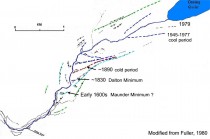
Figure 3. Successive positions of the terminus of the Deming glacier on Mt. Baker from the Little Ice Age to 1979. Each of these terminal positions corresponds to strong readvances of ice during periods of climatic cooling, separated by periods of glacial recession. The climate has been generally warming for 500 years coming out of the Little Ice Age, well before atmospheric CO2 began to rise after 1945, and has been characterized by alternating periods of warming and cooling to the present, not gradually warming because of increased CO2. The glaciers on Mt. Rainier and Mt. Adams show similar fluctuations.
Let’s look at the second contention--Mt. Adams glaciers are receding faster than those of nearby sister volcanoes. The advance and retreat of glaciers on two of those sister volcanoes, Mt. Baker and Mt. Rainier, has been well documented (Figure 4) (see references in Easterbrook 2011 and 2010).
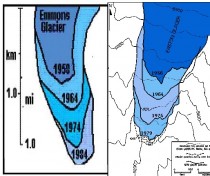
Figure 4a. Advance of more than 1 km of the Emmons glacier terminus on Mt. Rainer from 1958 to 1984. Figure 4b. Advance of the Easton glacier from 1956 to 1979
Glaciers on Mt. Rainier and Mt. Baker advanced strongly during the 1880 to 1915 cool period, retreated strongly during the 1915 to 1945 warm period, advanced again during the 1945 to 1977 cool period, and retreated during the 1978 to 1998 warm period. The contention that Mt. Adams glaciers are retreating faster than those on nearby volcanoes and that they have been retreating gradually since 1904 is false. Glaciers on Mt. Adams have not been gradually retreating and are ‘not retreating faster than the others’--all of these volcanoes have fluctuated strongly back and forth during each period of warming and cooling.
The third contention of the study, that glacier recession is another sign of gradually warming temperatures is only partially true. Although climatic warming does indeed cause glacier recession, the inference that gradual warming has caused gradual glacier retreat since 1904 is not true. The glaciers have clearly been periodically advancing as well as retreating.
The forth contention of the study, that the study lends urgency to an earlier federal report that shows the water content of Cascade Mountain snowpacks could dwindle by as much as 50 percent by the 2070s is totally unfounded. It assumes (1) that gradual climatic warming dating back to 1904 will continue at a constant rate until 2070, (2) that the supposed warming is continuous, (3) that the climate will continue to warm, and (4) that it is caused by increasing atmospheric CO2. The first assumption of gradual warming since 1904 has been shown above to be incorrect-there have been warming and cooling periods that have caused glaciers not only to retreat, but also to advance during this time. The assumption that the climate is presently warming is also not true--in fact, the climate has been cooling slightly since 2000, not warming, so projecting continuous gradual warming into the future is not warranted.
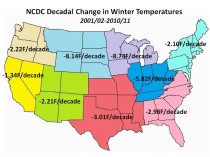
Figure 5. Winter temperatures in the US over the past decade. Note that temperatures in the Pacific NW have cooled at a rate of 2.22F per decade, not warmed.
The assumption that CO2 is causing climatic warming is also not true. Much of the glacial retreat was caused by climatic warming that occurred from 1915 to 1945, well before atmospheric CO2 began to rise sharply, so this warming cannot be attributed to rising CO2. In addition, the glacier readvance from 1945 to 1977 was caused by climatic cooling during the same time that CO2 was rising most rapidly, just the opposite of what should have happened if CO2 caused climatic warming.
So what credence can be given to the contention that Cascade Mountain snowpacks could dwindle by as much as 50 percent by the 2070s? Temperatures in the Pacific NW have been cooling over the past decade, not warming (Figure 5, 6) and the snowpack in 2010 was about 70-200% above normal. In the late summer of 2011, some areas normally snow-free were still covered with 30 feet of snow. Thus, the conclusion of Cascade snowpacks declining by 50% by the 2070s is not credible.
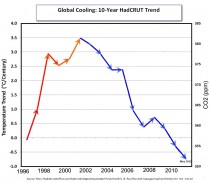
Figure 6. The trend of global temperature since 2001 has been cooling at a rate of -4.0C (-7F) per century. Computer models had predicted a 1F rise in temperature during this same period- that did not happen, showing that the computer models are invalid.
Summary
1. Rather than glacial retreat since 1904 due to gradual warming, glaciers have advanced and retreated four times in the past century.
2. Glacier termini advanced from 1945 to 1977 during the time of most sharply rising atmospheric CO2,. showing that rising CO2 does not cause climatic warming.
3. Glacier recession on Mt. Adams does not prove a gradually warming temperature.
4. No climatic warming has occurred during the past decade. Instead a cooling trend of -7 F per century has occurred.
5. Cooling during the past decade is not consistent with a claim of 50% reduction of Cascade snowpack caused by climatic warming.
6. The 1904 position of glacier termini resulted from strong cooling from 1880 to 1915. Comparing the position of recent minimal glacier termini following 20 years of warming from 1978 to 1998 with 1904 maximum glacier termini gives an exaggerated view of glacier recession.
7. Because glaciers on Mt. Rainier and Mt. Baker advanced and retreated four times in the past century, there is no basis for assuming that glaciers on Mt. Adams are retreating faster than those on nearby volcanoes.
References
Easterbrook, D.J., ed., 2011, Evidence-based climate science: Data opposing CO2 emissions as the primary source of global warming: Elsevier Inc., 416 p.
Easterbrook, D.J., 2011, Geologic evidence of recurring climate cycles and their implications for the cause of global climate changes: The Past is the Key to the Future: in Evidence-Based Climate Science, Elsevier Inc., p.3-51.
Easterbrook, D.J., 2010, A walk through geologic time from Mt. Baker to Bellingham Bay, WA: Chuckanut Editions, Bellingham, WA, 329 p.
PDF has enlarged images
Spectacular on a clear, sunny day, Mount Adams rises a scant 53 miles from Yakima.
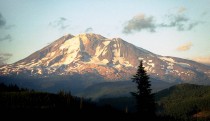
But the mountain holds what until now has been pretty much a secret.
In the first comprehensive study of its kind, a Portland State University study has found Mount Adams’ 12 glaciers have shrunk by nearly half since 1904 and are receding faster than those of nearby sister volcanoes Mount Hood and Mount Rainier.
It’s another sign of gradually warming temperatures that - if continued as expected by researchers - will mean significant problems for the water-dependent Yakima Valley.
The study lends urgency to an earlier federal report that shows the water content of Cascade Mountain snowpacks could dwindle by as much as 50 percent by the 2070s.
----------------------
The Portland State University study suggests that Washington’s gradually warming temperatures have caused Mount Adams’ to shrink by nearly half since 1904 and are receding faster than those of nearby sister volcanoes Mount Hood and Mount Rainier, but the National Climatic Data Center figures copied below indicate the following:
· Washington’s annual temperatures trended downward slightly at a rate of 0.07 degrees F per decade from 1895 through 1985.
· Washington’s annual temperatures trended downward more rapidly at a rate of 0.39 degrees F per decade from 1986 through 2011.
Portland State University suggests that Washington has been gradually warming since 1904, but the National Climatic Data Center data indicates that Washington’s annual temperatures trended downward slightly from 1895 through 1985 and then trended downward more rapidly from 1986 through 2011. These two periods of downward trending Washington annual temperatures were separated by a curious and unexplained temperature step change increase of 3.6 degrees F occurring between 1985 and 1986.
Ken Schlichte
Gordon Fulks adds: “The quilty party is likely Andrew Fountain at PSU. He has hawked this sort of rubbish for years by picking those cases where glaciers have retreated and ignoring those where they have advanced. He also chooses the period of record as the entire 20th century, when he knows that much of the retreat occurred up to and during the Dust Bowl era of the 1930s before CO2 could have been a “problem.” When I nailed him about this at a seminar at PSU last summer, he refused to answer and quickly ducked out of the room. He clearly knows that he is vulnerable but has gotten away with this poor excuse for science for many years.”
Annual Temperature
Washington
--------------------------------------------------------------------------------
Some of the following data are preliminary and have not been quality controlled.
For official data, please contact the NCDC Climate Services and Monitoring Division at ncdc.orders@noaa.gov.
Annual 1895 - 1985 Data Values:
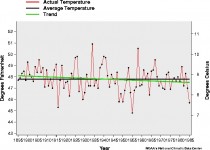
Annual 1895 - 1985 Average = 47.81 degF
Annual 1895 - 1985 Trend = -0.07 degF / Decade
(Enlarged)
Annual Temperature
Washington
--------------------------------------------------------------------------------
Some of the following data are preliminary and have not been quality controlled.
For official data, please contact the NCDC Climate Services and Monitoring Division at ncdc.orders@noaa.gov.
Annual 1986 - 2011 Data Values:
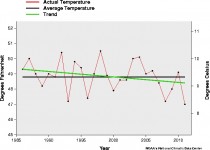
Annual 1986 - 2011 Average = 48.85 degF
Annual 1986 - 2011 Trend = -0.39 degF / Decade
(Enlarged)
UPDATE: First snow in 40 Years in North India
From Madhav Khandekar
For the first time in 40 years, Pathankot in Punjab state, at the foothills of the Himalanyan range of mountains, experienced snow fall.
My simple assessment; snow and colder condions have beceome more frequent in Himalayan foothills in the last ten years. In 2010 and also in 2011 January several hundred people (mostly elderly living in poor houses, ) died due to long exposure to low temperatures. Last January ( 2011) when I was in India, max temp in many north Indian cities would be just at 12C to 15C! This is COLD for North where about 250 to 300 M people live and most of the houses have NO heating at all! At best some small room heaters! Also the houses are NOT well insulated, so the cold wintry weather is felt inside the houses day long!
--------------------
(CNSNews.com) - A study by the Government Accountability Office (GAO) determined that the United States funded the Intergovernmental Panel on Climate Change (IPCC), the United Nations’ authority on alleged man-made global warming, with $31.1 million since 2001, nearly half of the panel’s annual budget.
The GAO also found that this funding information “was not available in budget documents or on the websites of the relevant federal agencies, and the agencies are generally not required to report this information to Congress.”
In a Nov. 17, 2011 report, “International Climate Change Assessments: Federal Agencies Should Improve Reporting and Oversight of U.S. Funding,” the GAO found that the State Department provided $19 million for administrative and other expenses, while the United States Global Change Research Program (USGCRP) provided $12.1 million in technical support through the U.S. National Science Foundation (NSF), averaging an annual $3.1 million to the IPCC over 10 years—$31.1 million so far.
The IPCC runs an annual budget of $7 million, according to the Wall Street Journal, making the United States a major benefactor for its global warming agenda.
An international body, the IPCC was created in 1988. Though thousands of scientists contribute to the panel, only 11 working members support the organization. Set up by the World Meteorological Organization (WMO), the IPCC is an “effort by the United Nations to provide the governments of the world with a clear scientific view of what is happening to the world’s climate,” according to its Web site.
The organization has been the subject of controversy in the last several years when thousands of e-mails from the University of East Anglia’s (UEA) Climatic Research Unit (CRU) were stolen and released in 2009, and again in November 2011, on the eve of climate talks in Durban, South Africa.
The e-mails included those between Michael Mann, the director of the Earth System Science Center at Penn State University and author of the infamous “hockey stick” graph that apparently showed global temperatures reaching “unprecedented” levels, and Phil Jones, director at CRU, which brought into question the validity of the IPCC’s work, with the reported statements “hide the decline,” and “Mike’s Nature Trick.”
In explaining its reason for auditing U.S. funding of the IPCC, the GAO said, “Interest in IPCC’s activities increased after the theft of e-mails among IPCC scientists was made public, and with the discovery of several errors in its 2007 set of reports.”
The IPCC’s Fourth Assessment Report (AR4), released in 2007, included several errors, including claims that the Himalayan glaciers would melt by the year 2035, which the IPCC, in a statement, later admitted was based on inconclusive data.
After facing “key challenges” in determining the amount of funding to the IPCC, the GAO now recommends that U.S. funding be reported annually to Congress with “accurate and consistent information.”
The report said documents on U.S. financing for the IPCC were “not available in budget documents or on the websites of the relevant federal agencies, and the agencies are generally not required to report this information to Congress.”
Conflicting State Department numbers also made it more difficult for the GAO to assemble the data. The GAO “reviewed documents and interviewed officials from federal agencies and IPCC” to reach its findings.
A 2005 GAO report entitled “Federal Reports on Climate Change Funding Should Be Clearer and More Complete” found that federal funding for climate change was not adequately accountable. “Congress and the public cannot consistently track federal climate change funding or spending over time,” the report concluded.
The report also found federal funding for global warming had increased by 116 percent between 1993 and 2004, to $5.1 billion.
The $3.1 million annual U.S. funding goes towards the IPCC’s “core activities”: meetings of the governing bodies, co-ordination meetings, support for the developing country co-chairs, the IPCC Web site and Secretariat. The IPCC assesses scientific information, but does not conduct any research of its own.
According to the U.S. Climate Change Science Program, the United States “has made the world’s largest scientific investment in the areas of climate change and global change research” with a total of nearly $20 billion over the past 13 years.
Time to defund the entire UN and climate science program.. since they claim the science is settled. We are not spending billions trying to confirm gravity. While the world worriies about paying their energy bills and finding jobs, Gore, Pachauri, Hansen, Mann, Trenberth, Gillard, Solomon, Karl, Stern, Huhne, the demonic trio of Holdren, Van Jones and Jackson not to mention the faceless EU bureaucrats in Brussels and their brainless UN counterparts in New York and at the enviro fascist groups with gentle appealing names like Greenpeace, the World Wildlife Fund and the Sierra club are committing global sovereign ecocide at our expense.
WHAT IS MEANT BY THIS NEWLY COINED TERM: “SOVEREIGN ECO-CIDE?”
Posted 6 January 2012 by Terry Dunleavy, NZ Climate Science Coalition.
If ‘sovereign debt’ is now acceptable as economic jargon popularised by the global financial meltdown, let me have a crack at inventing a new term, ‘sovereign eco-cide” as descriptive of how nations can inflict on themselves economic suicide by means of carbon taxes, emissions trading schemes, cap-and-trade madness , etc, caused by the myth that human and animal emissions of carbon dioxide can cause ‘dangerous global warming’. For what led to this invention, see three links below - Terry Dunleavy, New Zealand Climate Science Coalition.
